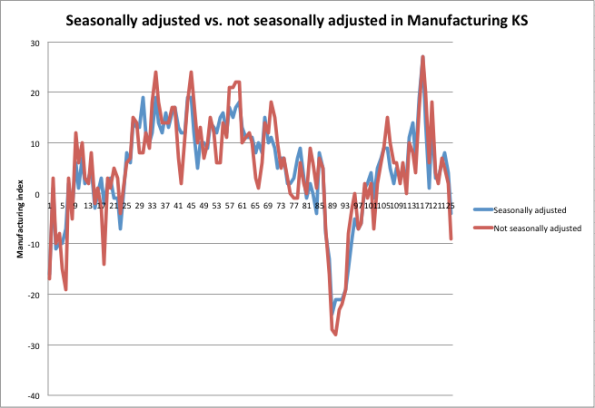Seasonally adjusted news
In one of my first posts ever, I talked about seasonal adjustment models and how they can work. I was sick of seeing that phrase go unexplained in the news all the time.
If I had been a bit more thoughtful, maybe I could have also mentioned various ways seasonal adjustment models could screw things up, or more precisely be screwed up by weird events. Luckily, a spokesperson from Goldman Sachs recently did that for me, and it was mentioned in this Bloomberg article. Those GS guys are smart, and would only mention this to Bloomberg if they thought everyone on the street knew it anyway, but I still appreciate them strewing their crumbs (it occurs to me that they might be trading on people’s overreactions to inflated good news right now).
Recall my frustration with seasonal adjustment models: they typically don’t tell you how many years of data they use, and how much they weight each year. But it’s safe to say that for statistics like unemployment and manufacturing, multiple years are used and more recent years are at least as important as older years. So events in the market that occurred in 2008 are still powerfully present in the seasonal adjustment model.
That means that, when the model is deciding what to expect, it looks at the past few years and kind of averages them. One of those years was 2008 when all hell broke loose, Lehman fell, TARP came into being, and Fannie, Freddie, and AIG were seized by the government. Lots of people lost their jobs and the housing and building industries went into freefall.
So the model thinks that’s a big deal, and compares what happened this year to that (and to the other years in the model, but that year dominates since it was such an extreme event), and decides we’re looking good. Here’s a picture from the Kansas Fed of the raw vs. seasonally adjusted manufacturing index results, from July 2001 to December 2011:
As one of my readers has already commented (darn, you guys are fast!), this just refers to manufacturing near Kansas, but the point I’m trying to make is still valid, namely that the seasonal adjustments clearly pale in comparison to the actual catastrophic event in 2008. However, that event still informs the seasonal adjustment model afterwards.
Because of the “golden rule” I mentioned in my post, namely that seasonal adjustment needs to on average (or at least in expectation) not add bias to the actual numbers, if things look better than they should in the second half of the year, that means they will look worse than they should in the first half of the year.
So be prepared for some crappy statistics coming out soon!
I still wish they’d just show us the graphs for the past 10 years and let us decide whether it’s good news.




I read this interesting article on the UK GDP today http://www.bbc.co.uk/news/business-16697093 Basically it points out that at the time the Office For National Statistics first publishes GDP figures, it only has about 40% of the actual data, so it does seasonal adjustment and similar to get the published figure. However it will be a couple of years before it has all the real GDP data for the last quarter – so its damned whatever it does. There is simply no other way to get reasonable estimates in a timely fashion. And while the details will vary, I suspect that similar issues will plague other countries’ statistics (and other statistics apart from GDP).
LikeLike